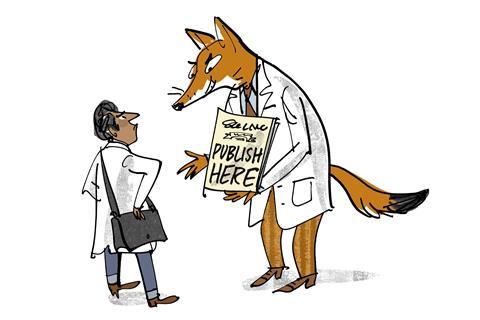An over-reliance on publishing has left scientists prey to unscrupulous practices

In Alice in Wonderland, Lewis Carroll writes: ‘Humans are animals that like to write letters’. To paraphrase, ‘Scientists are animals who like to publish papers’. Or maybe it’s not that they like to, but because they have to. Early career researchers in particular are under constant pressure from the publish or perish culture of academia, where the metrics used to assess researchers primarily focus on number of publications rather than quality. It’s therefore not surprising that some academics fall prey to predatory publication practices.
While teaching a class on research and publication ethics, I was struck by how predatory journals are a lot like natural predators – with scientists as their prey. (Though some unscrupulous researchers take advantage of this way of communicating their work and might become victims of their own making.) As bait, predatory journals use the metric system used for evaluating scientists. They trap researchers by presenting inflated impact factors, featuring fake editorial boards that falsely list respected scientists and even better mimic of legitimate journals. Predatory journals camouflage themselves by misrepresenting how they select articles for publication, claiming to use peer review when there are in fact no quality controls or other checks. Furthermore, they keep increasing their hunting base, using mass emails to identify their next target and invite researchers to guest edit a special issue (bringing in more of their network). Even a seasoned academic veteran can fall prey to such attacks.
As long as researchers continue to show an insatiable appetite to publish as quickly as they can in journals with high impact factors, it is almost impossible to eradicate predatory publishing. And this appetite will continue as long as publications are the main tangible outcome of scientific endeavours – as long as they are what make researchers visible to their peers and help them move up the academic ladder.
To create a thriving research community, we need to stop using peer reviewed publications as the main marker of success. Instead we need to find stable funding scenarios for supporting scientists, provide sustainable career growth trajectories, and develop a system that protects the interests of science. The academic community needs to value intangible work such as inculcating scientific rigour and ethics, and fostering leadership qualities in mentees.
The scientific publishing process also needs to be reviewed. We need to have avenues wherein we can legitimately publish our ‘negative’ outcomes. Equitable access of scientific work for authors and readers should also be ensured. Everyone should be free to learn; knowledge should be disseminated as widely as possible with less profit driven mentality.
We also need to find new ways of sharing our research – ways that also help us to maintain research integrity
Enter preprints. This method of publicly sharing un-peer-reviewed manuscripts can simultaneously safeguard new ideas from being scooped and can also solicit informed feedback from the community. Preprints can be a rapid, fair and inclusive way to disseminate new work to the scientific community. I believe we should adopt a post-publication peer review process based around preprints, which would overcome the usual problem where peer review is often the rate determining step of publication.
The peer review process underpins the growth and vitality of modern science, but it is far from perfect. New experiments need to be tried to improve its inherent weaknesses. Therefore, I support the initiative recently adopted by the journal eLife to peer review and publish articles without adding the usual tag of acceptance or rejection; instead, articles will be published as ‘reviewed preprints’ alongside comments from the reviewers and authors and an assessment summary from the editor. This process places more responsibility back on the authors and readers. For example, authors can choose whether they address all the points raised by the reviewers before final publication. This could make it easier to introduce new, disruptive ideas. It also allows readers to better judge the validity of scientific findings for themselves, rather than simply using the journal’s reputation as a proxy for quality and merit. This would also change our mindset when assessing scientific work. eLife’s initiative is indeed avant-garde, but I think it could significantly alter the publish or perish culture landscape.
As well as supporting open science and new publication methods, scientists should unite to stop peer reviewing articles for journals that solicit high publishing fees and show predatory features. This in principle could collapse the whole system of predatory journals. We also need to find new ways of sharing our research – ways that also help us to maintain research integrity, which is vital for science to thrive.
Finally, many people in the scientific community are using game-changing tactics to try to shake up how science is communicated. For this to happen, we need to not just nudge the system; we need to apply the brute force of constant shaking to destroy the structure that supports unethical publishing practices and the predators that profit from them.












No comments yet